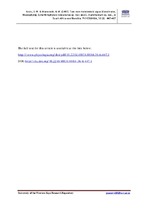| dc.contributor.author | Keats, Derek | |
| dc.contributor.author | Maneveldt, Gavin | |
| dc.date.accessioned | 2014-03-31T13:57:43Z | |
| dc.date.available | 2014-03-31T13:57:43Z | |
| dc.date.issued | 1997 | |
| dc.identifier.citation | Keats, D.W. & Maneveldt, G.W. (1997). Two new melobesioid algae (Corallinales, Rhodophyta), Synarthrophyton robbenense sp. nov. and S. munimentum sp. nov., in South Africa and Namibia. Phycologia, 36 (6): 447-467 | en_US |
| dc.identifier.issn | 0031-8884 | |
| dc.identifier.uri | http://hdl.handle.net/10566/1067 | |
| dc.description.abstract | Synarthrophyton robbenense sp. nov. and S. munimentum sp. nov., the fourth and fifth species in this apparently southern hemisphere genus, are described from southern Africa. Synarhrophyton robbenense occurs on rock and shells in the subtidal zone. Its thalli are minutely warty, with the surface covered by short, narrow protuberances that are fused into elongate, scrolled structures. The surface [scanning electron microscopy (SEM)] is of the Leptophytum type. Mature tetraibisporangial conceptacles have raised rims and sunken pore plates. The pore plates are composed of filaments made up of two or three
cells plus an enlarged epithallial cell. The pore canal is lined by filaments with cells that do not differ in size or shape from those of the other filaments making up the pore plate. Cells of filaments within the tetrasporangial and bisporangial conceptacle
rim are narrower and more elongate than cells of the pore plate and surrounding vegetative filaments. Tetralbisporangial pores are surrounded by five to eight rosette cells that tilt somewhat toward the pore in surface SEM view. Tetraibisporangial conceptacles do not become buried in the thallus, but are shed on senescence, often leaving shallow
craters on the surface. Synarthrophylon munimenlum occurs on rocks and shells in low-shore tide pools, and on rock, shells, and kelp holdfasts in the subtidal zone. Thalli are usually smooth, occasionally warty, but never show protuberances that are fused into scrol l-like structures. The thallus surface (SEM) is made up of Leptophytum-type epithallial cells. Tetral
bisporangial conceptacle roofs are volcano-shaped with a raised peripheral rim and sunken pore plate. The pore plates are composed of filaments made up of five to seven cells plus an epithallial cell. The rosette cells that surround the tetral bisporangial pore are distinct from surrounding roof cells (SEM, surface view) in being narrower and sunken below the level of the surrounding pore plate. The pore canal is lined by filaments with cells that do not differ in size or shape from those of the other filaments making up the pore plate. Cells of filaments within the tetrasporangial and bisporangial conceptacle rim are more or less similar in size and shape to cells of the pore plate and surrounding vegetative filaments. | en_US |
| dc.language.iso | en | en_US |
| dc.publisher | International Phycological Society | en_US |
| dc.rights | © 1997 International Phycological Society. | |
| dc.source.uri | http://dx.doi.org/10.2216/i0031-8884-36-6-447.1 | |
| dc.subject | Epithallial cell | en_US |
| dc.subject | Leptophytum-type | en_US |
| dc.subject | Synarthrophylon munimenlum | en_US |
| dc.subject | Tetraibisporangial conceptacles | en_US |
| dc.title | Two new melobesioid algae (Corallinales, Rhodophyta), Synarthrophyton robbenense sp. nov. and S. munimentum sp. nov., in South Africa and Namibia | en_US |
| dc.type | Article | en_US |
| dc.privacy.showsubmitter | false | |
| dc.status.ispeerreviewed | true | |
| dc.description.accreditation | Web of Science | en_US |

